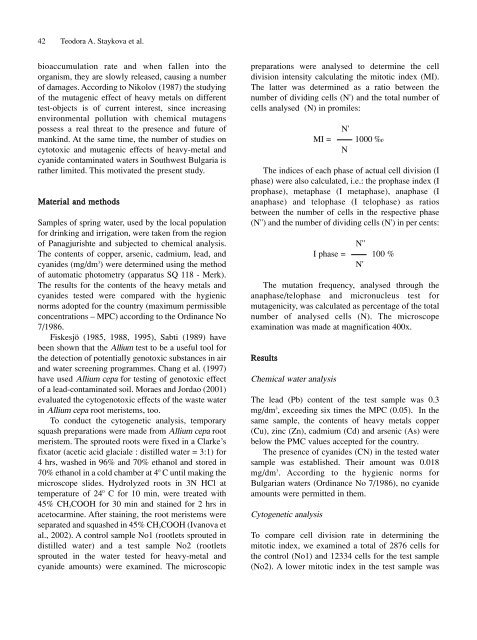Full Journal - Journal of Cell and Molecular Biology - Haliç Üniversitesi
Full Journal - Journal of Cell and Molecular Biology - Haliç Üniversitesi
Full Journal - Journal of Cell and Molecular Biology - Haliç Üniversitesi
You also want an ePaper? Increase the reach of your titles
YUMPU automatically turns print PDFs into web optimized ePapers that Google loves.
42 Teodora A. Staykova et al.<br />
bioaccumulation rate <strong>and</strong> when fallen into the<br />
organism, they are slowly released, causing a number<br />
<strong>of</strong> damages. According to Nikolov (1987) the studying<br />
<strong>of</strong> the mutagenic effect <strong>of</strong> heavy metals on different<br />
test-objects is <strong>of</strong> current interest, since increasing<br />
environmental pollution with chemical mutagens<br />
possess a real threat to the presence <strong>and</strong> future <strong>of</strong><br />
mankind. At the same time, the number <strong>of</strong> studies on<br />
cytotoxic <strong>and</strong> mutagenic effects <strong>of</strong> heavy-metal <strong>and</strong><br />
cyanide contaminated waters in Southwest Bulgaria is<br />
rather limited. This motivated the present study.<br />
Material <strong>and</strong> methods<br />
Samples <strong>of</strong> spring water, used by the local population<br />
for drinking <strong>and</strong> irrigation, were taken from the region<br />
<strong>of</strong> Panagjurishte <strong>and</strong> subjected to chemical analysis.<br />
The contents <strong>of</strong> copper, arsenic, cadmium, lead, <strong>and</strong><br />
cyanides (mg/dm 3 ) were determined using the method<br />
<strong>of</strong> automatic photometry (apparatus SQ 118 - Merk).<br />
The results for the contents <strong>of</strong> the heavy metals <strong>and</strong><br />
cyanides tested were compared with the hygienic<br />
norms adopted for the country (maximum permissible<br />
concentrations – MPC) according to the Ordinance No<br />
7/1986.<br />
Fiskesjö (1985, 1988, 1995), Sabti (1989) have<br />
been shown that the Allium test to be a useful tool for<br />
the detection <strong>of</strong> potentially genotoxic substances in air<br />
<strong>and</strong> water screening programmes. Chang et al. (1997)<br />
have used Allium cepa for testing <strong>of</strong> genotoxic effect<br />
<strong>of</strong> a lead-contaminated soil. Moraes <strong>and</strong> Jordao (2001)<br />
evaluated the cytogenotoxic effects <strong>of</strong> the waste water<br />
in Allium cepa root meristems, too.<br />
To conduct the cytogenetic analysis, temporary<br />
squash preparations were made from Allium cepa root<br />
meristem. The sprouted roots were fixed in a Clarke’s<br />
fixator (acetic acid glaciale : distilled water = 3:1) for<br />
4 hrs, washed in 96% <strong>and</strong> 70% ethanol <strong>and</strong> stored in<br />
70% ethanol in a cold chamber at 4 0 C until making the<br />
microscope slides. Hydrolyzed roots in 3N HCl at<br />
temperature <strong>of</strong> 24 0 C for 10 min, were treated with<br />
45% CH 3COOH for 30 min <strong>and</strong> stained for 2 hrs in<br />
acetocarmine. After staining, the root meristems were<br />
separated <strong>and</strong> squashed in 45% CH 3COOH (Ivanova et<br />
al., 2002). A control sample No1 (rootlets sprouted in<br />
distilled water) <strong>and</strong> a test sample No2 (rootlets<br />
sprouted in the water tested for heavy-metal <strong>and</strong><br />
cyanide amounts) were examined. The microscopic<br />
preparations were analysed to determine the cell<br />
division intensity calculating the mitotic index (MI).<br />
The latter was determined as a ratio between the<br />
number <strong>of</strong> dividing cells (N') <strong>and</strong> the total number <strong>of</strong><br />
cells analysed (N) in promiles:<br />
N'<br />
MI = 1000 ‰<br />
N<br />
The indices <strong>of</strong> each phase <strong>of</strong> actual cell division (I<br />
phase) were also calculated, i.e.: the prophase index (I<br />
prophase), metaphase (I metaphase), anaphase (I<br />
anaphase) <strong>and</strong> telophase (I telophase) as ratios<br />
between the number <strong>of</strong> cells in the respective phase<br />
(N'') <strong>and</strong> the number <strong>of</strong> dividing cells (N') in per cents:<br />
N''<br />
I phase = 100 %<br />
N'<br />
The mutation frequency, analysed through the<br />
anaphase/telophase <strong>and</strong> micronucleus test for<br />
mutagenicity, was calculated as percentage <strong>of</strong> the total<br />
number <strong>of</strong> analysed cells (N). The microscope<br />
examination was made at magnification 400x.<br />
Results<br />
Chemical water analysis<br />
The lead (Pb) content <strong>of</strong> the test sample was 0.3<br />
mg/dm 3 , exceeding six times the MPC (0.05). In the<br />
same sample, the contents <strong>of</strong> heavy metals copper<br />
(Cu), zinc (Zn), cadmium (Cd) <strong>and</strong> arsenic (As) were<br />
below the PMC values accepted for the country.<br />
The presence <strong>of</strong> cyanides (CN) in the tested water<br />
sample was established. Their amount was 0.018<br />
mg/dm 3 . According to the hygienic norms for<br />
Bulgarian waters (Ordinance No 7/1986), no cyanide<br />
amounts were permitted in them.<br />
Cytogenetic analysis<br />
To compare cell division rate in determining the<br />
mitotic index, we examined a total <strong>of</strong> 2876 cells for<br />
the control (No1) <strong>and</strong> 12334 cells for the test sample<br />
(No2). A lower mitotic index in the test sample was

















